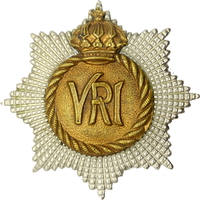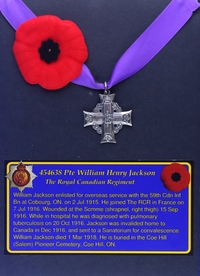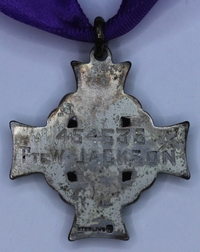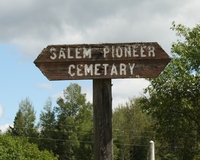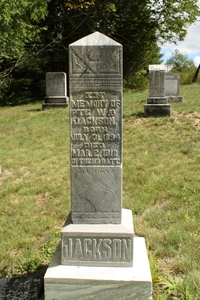
454638 Private William Henry Jackson
The Royal Canadian Regiment
By: Capt (ret'd) Michael M. O'Leary, CD, The RCR
William Henry Jackson was born 1 July 1894 in St. Ola, Wollaston Township (which is shown in Limerick Township on the 1901 census map), Hastings County, Ontario. Close to the current location of Coe Hill, Ontario, St. Ola was about 160 kilometres southwest of Ottawa.
In the 1901 Canadian census, William is shown living with his parents Thomas and Alice. At six years of age he is the only child and his parents in 1901 were both in their early 30s. By the 1911 census, Thomas and Alice are shown with three children at home, all younger than William and born since the last census. William, by then in his late teens, is no longer shown living with his parents in 1911.
William Jackson, a 21 year old lumberman, attested for overseas service with the 59th Canadian Infantry Battalion on 2 July 1915 at Cobourg, Ontario. He identified his father as his next of kin: Thomas Jackson, address P.O. Coe Hill, Ont., Canada. On his attestation paper, Jackson is described as 5 feet, 5 inches in height, weighing 103 pounds, with a fair complexion, blue eyes and light brown hair. Jackson stated that he had prior service with 49th Regiment (Hastings Rifles). He was a Methodist.
The 59th Canadian Infantry Battalion was authorized by General Order No. 103a of 15 Aug 1915. With a recruiting area covering Eastern Ontario and Hull, Quebec (and area), the battalion's mobilization headquarters was located at Barriefield Ontario. The unit served in Canada until 5 Apr 1916 at which time it sailed for England with 36 officers and 1073 men. William Jackson arrived in England with the 59th Canadian Battalion on 11 Apr 1916. The 59th Battalion is described in references as being absorbed into the 39th Battalion, which was itself absorbed by the 6th Reserve battalion in January 1917. But not all of the soldiers of the 59th Battalion went to the 39th. On 29 Jun 1916, a draft of 190 soldiers, including William Jackson, were taken on strength of The RCR.
The summer of 1916 was relatively quiet for The RCR. Except for a week-long tour in the front lines from 11-18 July 1916, the Regiment was in Divisional or Corps Reserve from early July until mid-September. The week they spent in the front trenches was occupied by patrolling no-man's-land; no major actions were fought and the reported casualties were light. In mid-September, however, the tenor of operations would change significantly.
It was also on 15 Sep 1916, the opening day of the battle of Flers Courcelette, that William Jackson was wounded. The Regiment was in action for three days after being ordered into the lines at USNA HILL on that date. The War Diary includes the following daily entries:
USNA HILL; 15.9.16. - Cloudy and fairly cool. At about 9.15 a.m. Regiment received orders to parade at once and proceed to USNA HILL there to await further orders. This was immediately done. Regiment less certain officers, instructors and specialists left at BRICKFIELDS arriving at USNA HILL at or about 11. a.m. The Officers left behind were the 2nd i/c, Adjutant, two Co. Commanders, two Co. 2nd i/c, 2 Specialist Officers as well as two W.O. instructors, six N.C.O. instructors and 15% of Specialists. For further movements see Appendix No. 6.A. (Appendix 6A)
TRENCHES; 16.9.16. - See Appendix No. 6.A.
TRENCHES; 17.9.16. - See Appendix No. 6.A. Lieut. LEWIS killed. Major COCK, Capt. TOWERS, Lieut. NAYLOR, Lieut. WURTELE wounded and to F.A. Lieut. BATE and Lieut. PENNIMAN wounded and at duty. Revised casualty list shows 264 O.R. Killed, Wounded and Missing. 110 O.R. joined as reinforcements, they were immediately put on square.
The noted appendix provides further details of the Regiment's actions during the day of Jackson's wounding and the days immediately following:
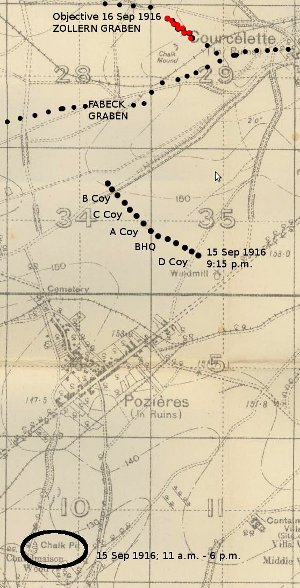
Approximate locations and movements of The RCR, 15-16 Sep 1916. Map extract from the online maps available through the McMaster University First World War map collection website.
Narrative of Events
15th, 16th & 17th September, 1916.
The Royal Canadian Regiment was bivouaced on the BRICKFIELDS (W.21.b) and at or about 9.15 a.m. on the 15th September 1916 order was received from the 7TH Canadian Infantry Brigade, commanded by Brigadier General A.C. Macdonell, C.M.G., D.S.O., to proceed at once to USNA HILL and there await further instructions. The Regiment duly arrived at or about 11 a.m. and later on instructions were received for us to proceed to the CHALK PITS (X.10.c). At 6 p.m., the Regt. moved forward to Old British Line R.35.c.6.5. to R.34.b.4.5. with left flank on road in R.34.b.4.5. and again awaited further orders. We were the Reserve Battalion in the Bde. Bn. Hdqrs. were established in an open trench at R.35.c.1.8. At 9.15 p.m. on the 15th the Bn. was distributed as follows:- reading from right to left - "D" Co, Hdqrs, "A" Co, "C" Co., "B" Co. Up to this hour the casualties in the Bn. were about 15, including Lieuts. NAYLOR and BATE. The latter having his wound dressed returned to his Company with expedition. Rifle and M.G. fire were practically nil, but shellfire was very heavy, including all calibre. At 7.30 a.m. on the 16th Bn. Hdqrs were moved to a trench called CENTRE WAY (R.34.d.2.3.) in a deep dug-out. At about 1. p.m. I received instructions to proceed to Brigade Hdqrs. and there received orders for the R.C.R. to attack the ZOLLERN GRABEN between points R.29.a.6.5. and R.29.a.2.8. The 42nd Bn. co-operated on our left. We also had instructions that, having gained the objective, we should bomb S.E. to junction FABECK GRABEN and establish touch with the P.P.C.L.I. who were operating on our right. Zero time was 5. p.m. At this hour the Bn. was disposed as follows:- "A" Co. & "D" Co. in FABECK GRABEN, "C" Co. in SUGAR TRENCH, "B" Co. in OLD BRITISH TRENCH. The Artillery Barrage was to have commenced at 4.45 p.m., but according to reports the few shells that went over burst well in rear of the objective and caused practically no damage to the Hun, who was holding his line very thickly. "A" and "D" Cos. advanced about 75 yds from FABECK GRABEN in the face of extremely heavy rifle and M.G. fire together with considerable artillery fire. The casualties were heavy and the advance was held up about 150 yds from the ZOLLERN GRABEN. At this juncture Lieut. PENNIMAN, finding himself alone and unable to find any other fit men near him, proceeded to a point about R.29.a.8.5. where the Regimental Bombers, together with the P.P.C.L.I. were bombing up the ZOLLERN GRABEN. Here I understand the machine gun which had done considerable damage to us was put out of action by our bombs. At 6.25 p.m. orders were received to move "C" & "B" Cos. to FABECK GRABEN at once. The Bn. was in position in and about the FABECK GRABEN until relieved by elements of the 52nd and 60TH Bns. at or about 4. a.m. on the morning of the 17th, when we proceeded to bivouacs at TARA HILL. The total casualties as far as can be ascertained amount to 1 Officer killed, 4 wounded and about 279 O.R. killed, wounded or missing.
(Sgd) C.H. Hill, Lieut Col. Commanding The Royal Canadian Regiment
20/9/16
Jackson's wound on 15 Sep 1916 was caused by shrapnel in his right thigh, it was described in his medical documents by the generic label "Gun Shot Wounds." He was admitted to No. 9 General Hospital, Rouen, on 16 Sep 1916 where his wounds were dressed. After three days in hospital at Rouen he was evacuated to England.
On 21 Sep 1916, Jackson was struck off the strength of The RCR to the Canadian Casualty Assembly Centre (CCAC), Folkestone. He crossed the Channel on the hospital ship H.S. Panama and the following date was admitted to the Adm. Lord Derby War Hospital, Warrington, for further treatment of his wounds. Jackson's injuries were described as "External - Scar on anterior and one on posterior of right thigh. Internal - Anaemic, night sweats, cough in morning, coughs quite a bit, Debilitated." In addition to the shrapnel wounds to his leg, which were noted as involving "no damage to bone or nerve", Jackson was described as being in "poor" condition, "run down" and suspected as having Tuberculosis. His treatment at that time consisted of new dressings, a special diet, and no drill.
Jackson was transferred to Hillingdon House, Canadian Convalescent Hospital, at Uxbridge on 11 Oct 1916. Admitted for further treatment of the wounds on his thigh, it was here on 20 Oct 1916 that his lab results also showed "Positive T.B." Jackson was transferred again, this time to Moore Barracks Military Hospital, Shorncliffe, on 8 Nov 1916. His diagnosis at this time was "Pulmonary Tuberculosis. Night sweats and troublesome cough and free expectoration. Losing flesh rapidly, and marked dyspnoea on exertion. Active disease in right upper lobe and left apex. Sputum pos. for T.B."
On 13 Nov 1916, Jackson was examined to assess the nature and severity of his illness. He was diagnosed with Pulmonary Tuberculosis, which although it was determined to have commenced in Canada in 1914, was also exaggerated by his service conditions. His condition at the time of the examination was described as follows:
"Was never strong, always subject to colds, cough. Had a slight cough for months before enlistment but always worked hard at sawmill work. Cough increased since arrival in England in April 1916. In France three months. Wounded in right thigh on Sept 15th and returned to England. Wound almost healed, slight discharge still present. Has night sweats with troublesome cough and free expectoration. Losing flesh steadily and very short of breath especially on exertion."
Jackson's physical condition was described as "poor, very much emaciated, hectic flush (?), dyspnoea on least exertion." He tested positive for T.B. and the state of his lungs were "right lung diseased on whole upper lobe. Left lung shows disease as marked on chart (top section of upper lobe)." His weight at the time was 115 lb, but was also noted to have never been more than 120 pounds.
The doctors recommended that Jackson be discharged as permanently unfit. This was upheld by a medical board on 17 Nov 1916 and the decision approved the following day. On 8 Dec 1916, Jackson was sent to a Sanatorium Hospital at Hastings, from which he would be struck off strength on proceeding to Canada for discharge. Once back in Canada, on 18 Dec 1916, William Jackson proceeded to a Sanatorium near Montreal.
At the age of 23, William Henry Jackson died on 1 Mar 1918 as a result of the illness he suffered during his overseas service. He is buried in a family plot in the Coe Hill (Salem) Pioneer Cemetery just outside of Coe Hill, Ontario. Although Jackson was a soldier of The Royal Canadian Regiment overseas, his family knew him as a soldier of the 59th battalion, the unit with which he enlisted as left for the War. It was the title of the 59th Battalion that they placed on the family gravestone under his name.
The medals awarded to William Jackson, the British War Medal and the Victory Medal, were sent to his father, Mr. Thomas Jackson of Coe Hill, Ont. His Memorial Plaque and Scroll were also sent to his father while a single Memorial Cross was sent to his mother Alice.
Pro Patria
Visit a randomly selected page in The O'Leary Collection (or reload for another choice):
- The O'Leary Collection; Medals of The Royal Canadian Regiment.
- Researching Canadian Soldiers of the First World War
- Researching The Royal Canadian Regiment
- The RCR in the First World War
- Badges of The RCR
- The Senior Subaltern
- The Minute Book (blog)
- Rogue Papers
- Tactical Primers
- The Regimental Library
- Battle Honours
- Perpetuation of the CEF
- A Miscellany
- Quotes
- The Frontenac Times
- Site Map
QUICK LINKS
The O'Leary Collection—Medals of The Royal Canadian Regiment
Newest additions:
![]()
![]() SB-12725 Private Henry "Hank" Ard
SB-12725 Private Henry "Hank" Ard ![]()
WIA at Hill 187, Died of Wounds in Japan
![]()
![]() 2355331 Lance Corporal Albert Lorking
2355331 Lance Corporal Albert Lorking
Wounded in action, later a War Amps representative.
![]()
![]() 4334 / 477996 Pte Isaac Hamilton Wilcox
4334 / 477996 Pte Isaac Hamilton Wilcox
Permanent Force, South Africa, and C.E.F.
![]()
![]() 477019 Private Harold Ashcroft
477019 Private Harold Ashcroft
Transferred to the Tunnelers.
![]()
![]() 734231 Private Clark D. Thompson
734231 Private Clark D. Thompson ![]()
The older Thompson brother, killed in action.
![]()
![]() 733849 Private Norman Parker Thompson
733849 Private Norman Parker Thompson
The younger Thompson brother; post-war service in the Special Guard.
![]()
![]()
![]() A305 / 400305 Private Andrew Walker
A305 / 400305 Private Andrew Walker ![]()
"Previously reported Wounded, now Killed in Action."
![]()
![]() 823298 Pte Thomas Patrick Steele, M.M.
823298 Pte Thomas Patrick Steele, M.M. ![]()
… for gallant conduct in the field …
![]()
![]() P13066 Sergeant Harold Thompson
P13066 Sergeant Harold Thompson
Instrumental Soloist for over 20 years of Canadian Army service.
![]()
![]() 9609 / 477728 Private Albert Edward Piper
9609 / 477728 Private Albert Edward Piper
"Arrived from England as a STOWAWAY …"
